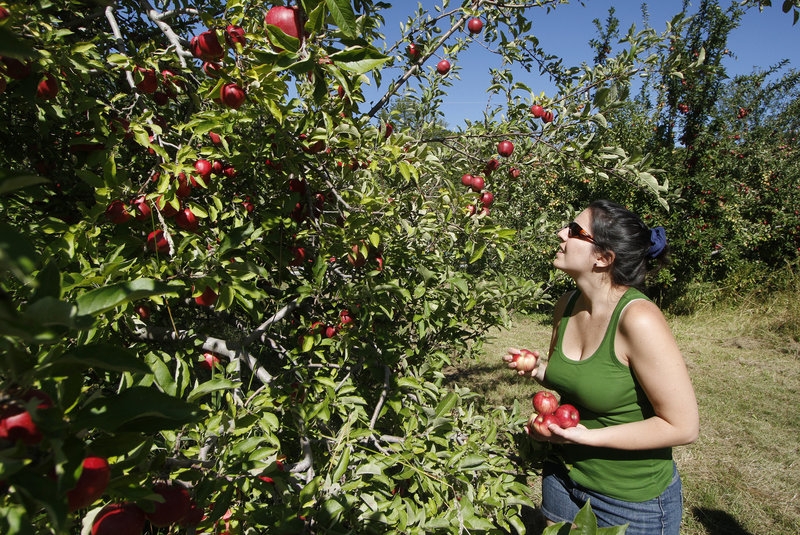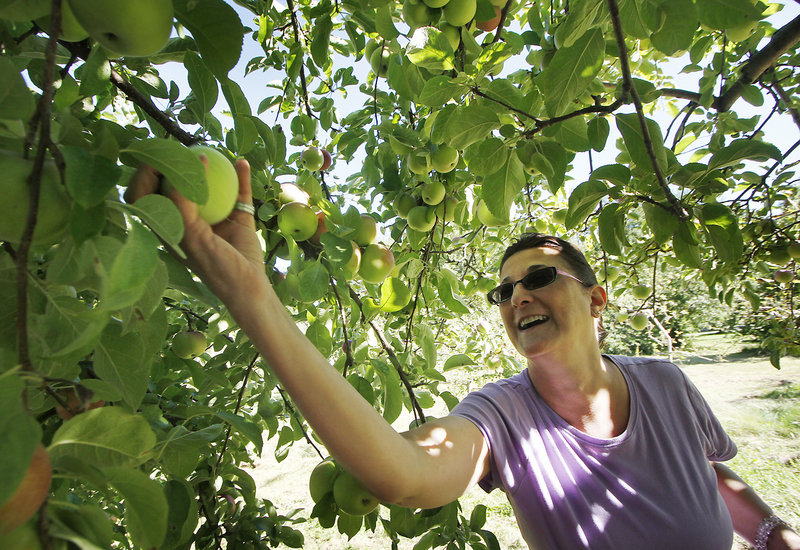Not so long ago, an apple was just an apple. As long as our fruit was colorful and crisp – and maybe organic – that was all we cared about. We went apple picking in the fall, made our pies, and called it good until next year.
In recent years, however, the public’s apple IQ has soared. Go to the farmers market – even the grocery store – and varieties are labeled so that you know more about your choices. Pick Gravensteins if you’re making a pie, Macouns for applesauce, Ginger Gold if you’re adding apple to a salad.
We also know more about rarer heirloom varieties, thanks in large part to Maine’s own John Bunker of Palermo, the man dubbed the “apple whisperer” by The Atlantic magazine.
While interest in apples is blossoming elsewhere in the country as well, Bunker has probably turned more Mainers onto the fruit than anyone else. Who knew apples could be white, orange, purple or even black? Or that the flavor of some of these older varieties could be so intriguing, giving us a glimpse into how our ancestors lived?
Bunker’s influence has led to orchardists planting more heirloom varieties to satisfy public demand, and the interest in learning more about antique apples is as high as it’s ever been. In October, the newly formed Downeast Food Heritage Collaborative will be hosting Downeast Heirloom Apple Week in Ellsworth, which will feature everything from an apple festival to school programs teaching children about the fruit.
The week’s events include lectures by Bunker; Peter Hatch, director of gardens and grounds at Monticello, Thomas Jefferson’s home in Virginia; and Ben Watson, author of a key reference book on cider, who will be talking about the history of hard cider and explain how to make it.
THE PERIPATETIC POMOLOGIST
For years, John Bunker has been traveling around Maine on “fruit explorations,” hunting down old trees in out-of-the-way orchards and abandoned farms that may have been bearing fruit for 100 years or more. He lectures around the state, always encouraging his audiences to bring in apples they’ve found in their old orchards so he can try to identify them and solve the mystery of where they originated.
I first interviewed Bunker in 2002, when he was passing around Old West-style “wanted” posters for apples he couldn’t identify. At the time, he had just rediscovered the Hayford Sweet, and was closing in on the Marlboro and the Fletcher Sweet.
Since that interview, while still sleuthing for apples, Bunker found time to write a book. During apple season, he gives at least one lecture a week. Four young apprentices now live with Bunker on his farm, hoping to soak up some of the pomological knowledge he has filled his head with over the years so it won’t be lost.
“They also help us do things like plant the peas and harvest garlic and bring in firewood,” Bunker said in an interview last week. “But their passion is learning about the apples, and how to take care of them and how to identify them and how to do the whole fruit exploration thing. It’s very rewarding. It’s fun. It keeps me on my toes, and it’s nice being with people who are a third my age.”
When I interviewed Bunker nine years ago, he estimated that of the 250 apple varieties that originated in Maine, about 30 had been rediscovered. He now says that number has probably doubled. Other rediscovered varieties may not have originated here, but were commonly grown because Maine’s oil and climate suited them well.
“Intuitively, one might think that at a certain point, I would have identified enough so that it would have tapered off,” Bunker said. “But it seems to be picking up steam, and I would attribute that to just the increased interest over time, that more and more people are thinking to themselves, ‘Oh geez, isn’t there a really old orchard right down in the neighborhood here? I wonder what that has?’ “
Sometimes, “new” old varieties simply land on Bunker’s doorstep. On the day we spoke last week, he had already taken four or five calls from people who either want to send him fruit to identify or want him to come search their orchard. Another group of people just showed up in their car that day with a bag of five or six varieties to give to the apple whisperer. And apples show up in Bunker’s mail, unsolicited, all the time.
Bunker tells people that, when they’re searching for old trees in an orchard, look for “the oldest of the old.” These are the trees that anyone, even someone who doesn’t know an apple from an oak tree, would take one look at and recognize that it’s really old. It also helps if the tree is hollow, because they tend to hollow out ovnly after they’ve been alive for 100 years or so.
Size? When it comes to apple trees, that doesn’t really matter. Bunker saw two apples trees in Bremen last week that were both 150 to 200 years old. One was small, the other was large. They were both still producing fruit.
“The big ones, it’s sometimes a clue that it’s an old tree,” Bunker said. “But some old trees are surprisingly small, because big original parts of it have fallen off and are long gone – so long gone that you can’t even really see the remnants, and what’s up now is maybe even a branch of the original that has sort of turned into a trunk.”
‘THEY’RE NOT MAKING IT UP’
For some varieties, Bunker has names but no fruit. For others, he has the fruit in hand but no name for it.
If someone comes to him and says they have a Peabody or Red Luxury or Hurlbut apple tree on their property, “then I think to myself, this is probably somebody I need to listen to, because they’re not making up these names,” Bunker said. “These are all classic names of rare varieties.”
Bunker did eventually find the Marlboro, named after a part of Lemoine, and if the tree is bearing fruit, he plans to bring some to the Common Ground Country Fair next weekend for the apple tasting. He also found the Fletcher Sweet, which is named for a part of Lincolnville called Fletchertown.
“It exists now,” Bunker said, “but all it is is a massive grove of sugar maples and long, long, long vacant cellar holes at the base of what was once called Fletcher Mountain, which is now called Moody Mountain, which is right in between Searsmont and Lincolnville.”
This fall, Bunker is looking for a variety called Bourassa that originated either in Maine or Canada and was grown down the coast.
“Last year, a woman from Downeast brought me a bunch of different apples from one old farm, but she didn’t keep track of which apples came from which tree,” Bunker said. “And one of them, I’m virtually positive, is Bourassa, but I don’t know which one. When I see the fruit on the trees, I’ll know which one it is.”
Interested in tasting some of these heirloom apples? For the past couple of years, Bunker has run an apple CSA, but it is sold out this year.
“I think orchards should do CSAs,” Bunker said, “because it gives the farmer the confidence to be a little more courageous than they might be otherwise to plant things that are different, because they know they’re going to sell them.”
The Common Ground fair tastings will be held at the Fedco booth on Sept. 23-24. Bunker also suggests coming to Great Maine Apple Day on Oct. 23 in Unity, where there will be about 100 varieties of apples for people to taste.
The Fedco catalog also publishes a list of orchards with interesting collections where people can go and buy some of the rarer varieties.
“What I recommend that people do who don’t have their own little orchard is to find a place and visit it regularly,” Bunker said. “See what new variety is coming out sometime in the next couple of weeks, and then go back once a week, or once every two weeks or something, and see what else is there.”
Who knows what you’ll find?
Staff Writer Meredith Goad can be contacted at 791-6332 or at:
mgoad@maine.rr.com
Twitter.com/Meredith Goad
Send questions/comments to the editors.






Success. Please wait for the page to reload. If the page does not reload within 5 seconds, please refresh the page.
Enter your email and password to access comments.
Hi, to comment on stories you must . This profile is in addition to your subscription and website login.
Already have a commenting profile? .
Invalid username/password.
Please check your email to confirm and complete your registration.
Only subscribers are eligible to post comments. Please subscribe or login first for digital access. Here’s why.
Use the form below to reset your password. When you've submitted your account email, we will send an email with a reset code.